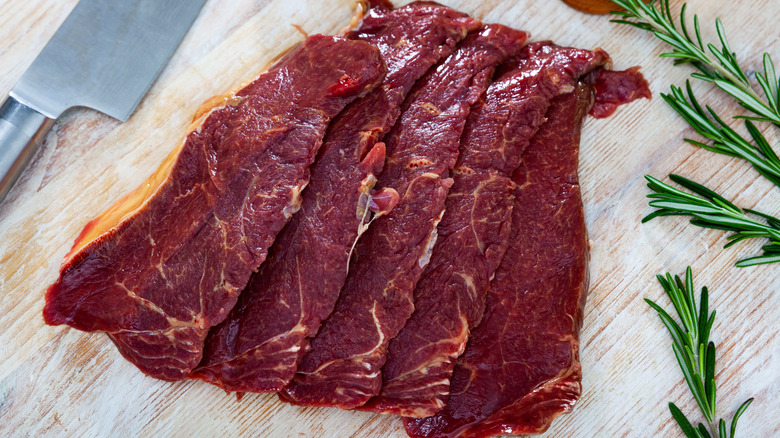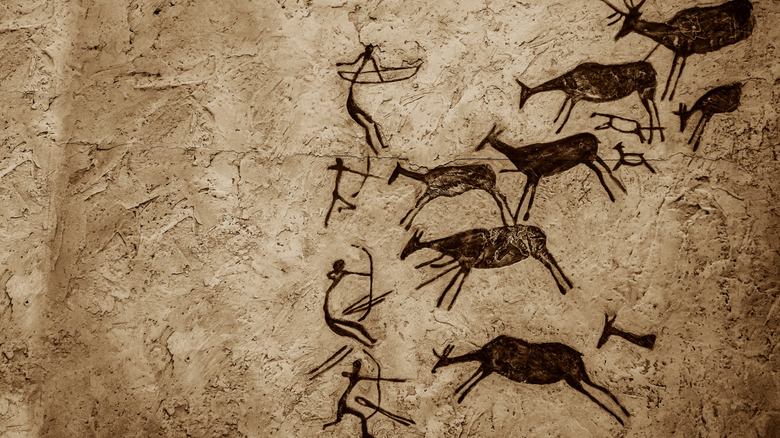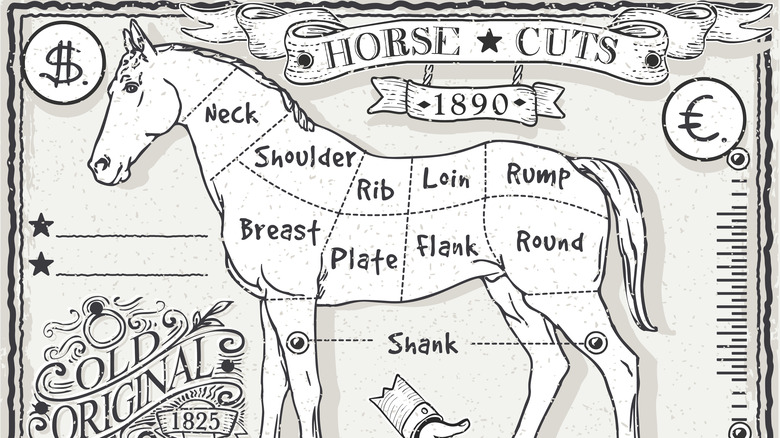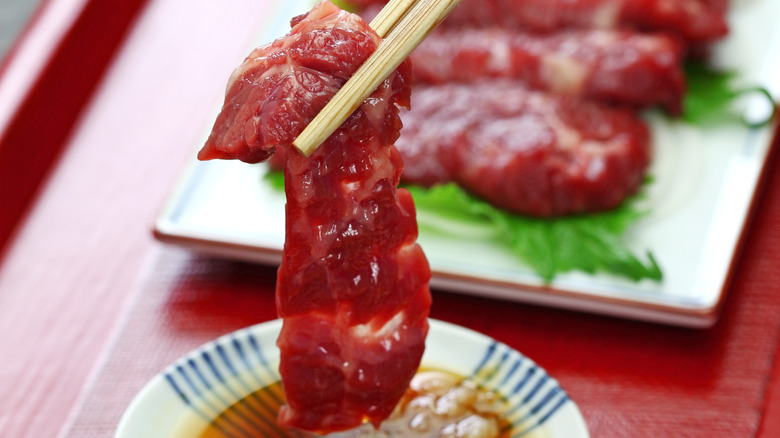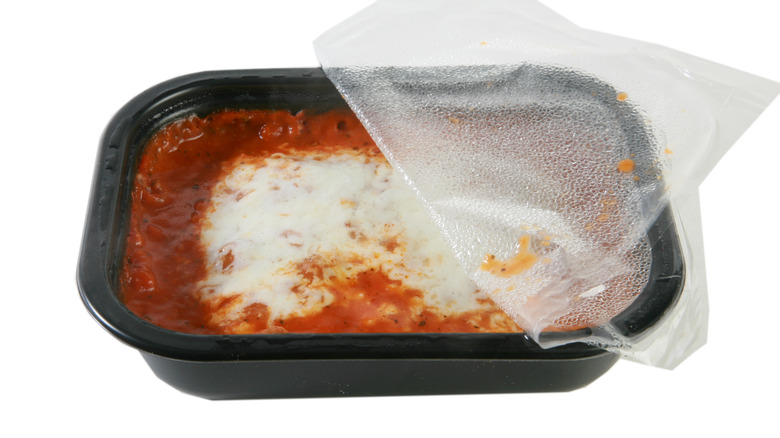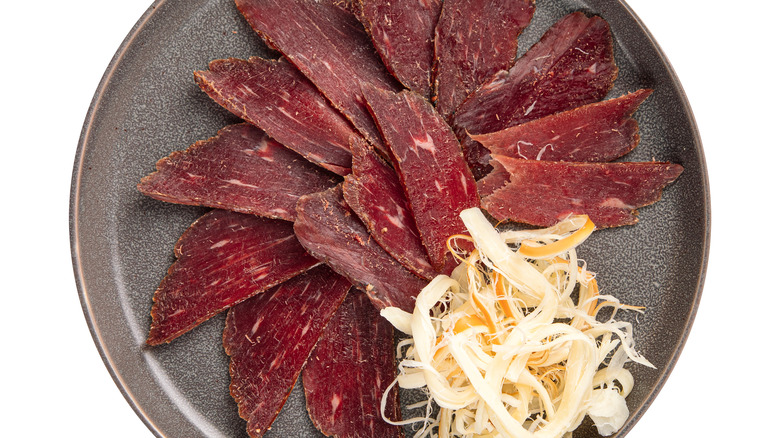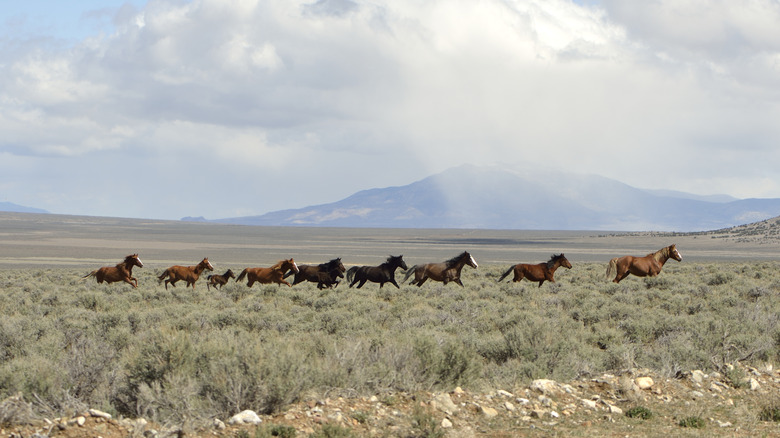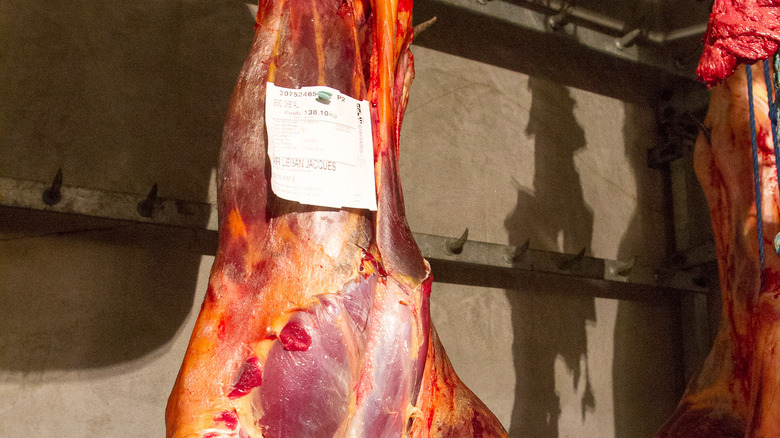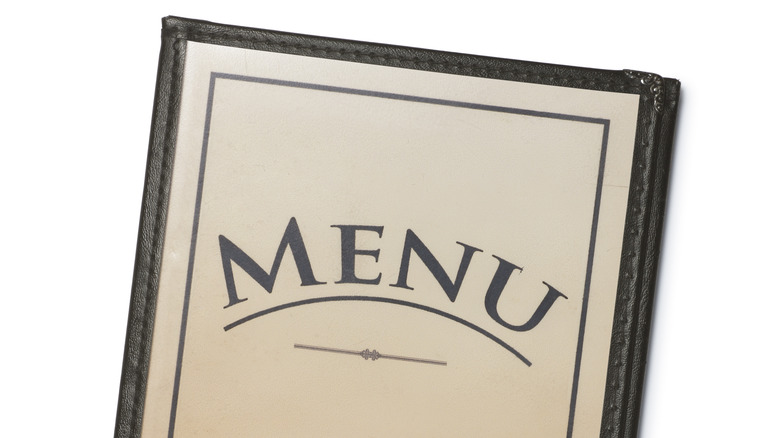10 Facts You Need To Know About Horse Meat
Horse meat is a controversial protein. Banned for human consumption in America along with being the subject of a 2013 European food scandal, where millions tucked into a bit of horse without knowing they were doing so, horse meat is as much of a protein choice for dinner as it is an ethical question.
While horse meat might just be another red meat (an extremely popular food in America), horse meat raises some tricky ethical and philosophical issues that beef mostly evades. However, horse meat is also widely consumed as a cultural food from France to Central Asia to Japan. And while the idea of horse meat might be squeamish to many, it's undeniable that this red meat has plenty of history and avid fans. At Tasting Table, we've decided to explore the history and culture behind this red meat, revealing everything from the scandals to its possible health benefits to legal issues.
People have eaten horse meat since ancient times
Eating horse meat is nothing new; the practice has been observed wherever horses are found, and dates back tens of thousands of years. The meat was a vital source of both energy and protein since the end of the last ice age, at the very least. Archeological evidence has also suggested that horse was part of the diets of the earliest known habitants of what is now known as Argentina.
Attitudes to eating horses haven't always been consistent. The consumption of horse meat may have declined a little around 6,000 years ago when the animals were first domesticated. This could be due to the value horses hold when they are being used for work, or it could also be down to human compassion. People tend to struggle with the concept of killing and eating things they are close to. Either way, horse was eaten long before many of the domesticated, farm-reared animals we now consume even existed.
It was taboo in France at one point
National tastes can change over time. If people are asked to name a country where horse meat is regularly consumed, France is the first answer on many people's lips. But this wasn't always the case. Roll back the clock, and the consumption of horse meat in France was pretty taboo. The consumption of horse meat was de facto banned in France, along with the rest of Europe, in 872 when Pope Gregory III issued an edict against it back in 873. The killing and eating of horses was seen as a pagan practice, and the Pope described dining on horse as a "filthy and abominable" practice.
As time went on, religious considerations became less of a factor — but horse meat's place in the French diet didn't improve much. It was seen as a cheap and low-quality meat, not something the upper or middle classes would be tucking into at a banquet. However, the French have always had a complex relationship with class — hence the period of time when introducing members of the aristocracy to "Madame la Guillotine" was all the rage. This could be why this poor man's meat saw a surge in popularity during the mid to late 19th century. As things stand, horse consumption in France is on the decline again, though it is still very common in large parts of the world. Particularly Central Asia.
It was briefly popular in the United States
While it is downright illegal to eat in some states and sell nationwide now, horse meat was a popular menu choice in the United States at one point. Horse meat consumption tends to be split into two categories. In some areas, it's a cultural thing. If you live in a country where eating horse meat is popular, it's looked upon the same way people in the U.S. look at things like beef and pork consumption.
In other nations, things like horses stay off the plate unless the country is going through a time of national struggle. This was the case in America. World War Two led to a scarcity of things like beef as protein-rich foods were sent to feed soldiers fighting in Europe and Asia. As a result, horse meat became popular. As well as arguably being a healthier alternative to beef, horse meat wasn't rationed. So people buying it could acquire and consume as much as they wanted. Consumption of horse meat carried on after the war, with advertisements at the time carrying lines like "young colt meat, tender delicious like fine veal." Eventually, consumption dropped off, lobbyists stepped in, and now the U.S. is one of the most difficult places to buy and eat horse meat worldwide.
The Japanese eat it sashimi style
Japan is one of the world's biggest importers of horsemeat, sourcing thousands of animals annually from places like Canada and serving up their flesh to locals and tourists alike. Japan's take on horse meat reflects the Asian nation's overall cuisine, and it also goes to show that not all horse meat is equal, even if it comes from the same horse.
The horsemeat dish known as "Basashi" is popular in Kumamoto Prefecture, a region in Japan's south. The dish is served "sashimi" style, so you can expect thinly sliced, raw cuts of meat. The meat comes in three varieties, with the most prized cut involving a soft, fatty cut taken from the horse's neck. The other two cuts contain trimmed, lean cuts of horse meat and a more tender, well-marbled variety. While this dish is strongly linked to the Kumamoto region, it can still be found in other areas of Japan. The dish is traditionally served with soy sauce, grated ginger, garlic, and sake.
People may have eaten it without knowing
While horse meat consumption isn't taboo in many parts of the world, it isn't a regular fixture on menus in America or Europe. Despite this, many Europeans may have consumed large amounts of horse without knowing. In around 2013, authorities in Ireland found a large amount of horse DNA present in a reasonable percentage of products labeled as beef. Up to a third of grocery store beef burgers tested contained an amount of horse. Other countries, including Britain, began testing their own products for the presence of animals that aren't exactly listed on the label.
The amount of horse varied from trace amounts that may be due to the equipment being improperly cleaned somewhere along the production line to the entire meat content of "beef" ready meals actually consisting of pony. Prior to 2013, food standards authorities hadn't tested products for the DNA of animals that weren't on the label.
It could be a healthy option
If certain studies are to be believed, horse meat may actually be a healthy option — as far as red meat goes, anyway. The tissue packs in a similar amount of protein to both beef and pork but contains noticeably less fat. Mineral contents were similar for the three meats, though the researchers noted that horse meat contained higher levels of retinol, and lower levels of niacin, than the two other meats. Niacin has been linked to diabetes, while consumption of retinol (or vitamin A as it's normally known) could be beneficial to skin health. The meat also contains higher levels of Omega-3 fatty acids than both beef and pork.
Beyond its micronutrient benefits and the meat's overall lower fat content, the fat it does contain may be a healthier choice than its bovine or swine equivalents. Horse fat contains less saturated fat than the lipids in beef and pork.
It might also be good for the environment
According to The Guardian, in 2015 the number of wild horses in the U.S. was nearly double the maximum limit set by the Bureau of Land Management (BLM). At the time, that was 50,000. In 2023, the BLM estimates there are close to 83,000 horses running wild in the United States. Horses aren't native to North America and have no natural predators — so without human intervention, their population is only going one way. The overpopulation of wild horses leads to habitat destruction, which can affect other species. On top of everything else, the government can't cull horses to help keep population numbers down. It's been pointed out that other animals considered pets, including cats and dogs, are regularly euthanized — but horses get a pass for some reason. Last year, over 20,000 wild horses were "removed" from the wild, and over 1,500 were sterilized.
This cost the taxpayer $138.462 million and may not be entirely necessary. Hunters eat a wide variety of game, such as moose, bullfrog, or gator, and adding horses to their list of quarries and menus could help protect the environment and other animal species. The practice is already used to manage numbers of other wild animals, including hogs, deer, and bears. The permitting process could also raise money that could then be used on other conservation projects.
It may be illegal in your area
If you want to try horse meat in the United States, you're in for a difficult time. The slaughter and sale of horse meat for human consumption is illegal in the United States. That means there are no horse farms where you can safely source the meat, and if one did exist, the government would almost certainly shut it down. In certain states, it isn't just the person selling the meat that will end up in hot water. According to World Population Review, the consumption of horse meat is a crime in Massachusetts, Hawaii, Rhode Island, and Delaware. Though provided you aren't in those four states; it is possible to legally dine on horse meat on U.S. soil.
If you want to legally eat horse meat, you'd need to legally own the horse destined for your dinnerplate, or you'd need the express permission of the horse's owner. The horse must then be disposed of humanely. Once you have a former horse on your hands, its meat can legally be given away or consumed by the person who owned the horse in 46 U.S. states. Despite this, you're better off just hopping across the border to Mexico or Canada. Grocery stores and specialty butcher shops in Quebec sell horse meat and the meat is also consumed in Mexico.
The source of the horse might be important
One of the main arguments activists have against the slaughter of horses for consumption is more medical than ethical. Horses have many functions in society. People race them, jump them, work with them, and keep them as pets. This is a stark difference from cows, which are either kept for the dairy products they produce or reared for meat. Everything that happens to those cows, from birth to slaughter, happens because they will be part of the human food chain when all is said and done. That means if medical treatment is given, certain medicines, antibiotics, and vaccinations are used. These will have all been approved by regulators for use on animals that are set to be slaughtered for food at one point.
Conversely, the medical treatments horses receive can be quite different. Medications could be used that may have adverse effects on humans if the horse is slaughtered and its meat is consumed within a certain period. In countries where horses aren't traditionally eaten, it's unlikely any are being raised with your dinner plate in mind. If you are planning on eating horse, make sure it's coming from a farm that breeds horses specifically for meat and not some unknown location.
Even if you want to avoid it, you should be familiar with the practice
If you've read through all of this and still want to avoid trying horse meat, you should still familiarize yourself with the practice. In some countries, eating horse is as common as eating beef, pork, or chicken in the United States. Many countries don't use English as a primary language either, and if you're trying out a local restaurant, the menus may only come in the local language, and the staff's grasp of English may not be in the "fluent" category.
So if you really don't want to order what you believe is a standard beef steak and accidentally wind up tucking into Secretariat, then you need to do your research ahead of time. Find out if horse meat is a regular part of your destination's diet. It may also be eaten on special occasions, so you should look into this too. Finally, research the words to describe the meat, so you can easily spot it on a menu. Basically, look into it with the same level of enthusiasm as someone who is happy to go out of their way to eat horse meat would, and you should be safe from any meaty accidents.
